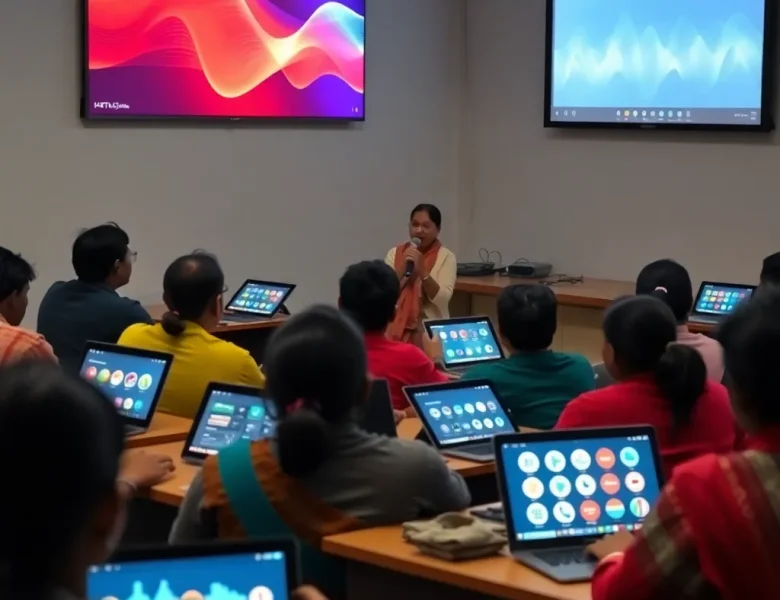Introduction
In today’s fast-paced digital world, businesses are always searching for ways to save time, reduce costs, and boost efficiency. One technology that has become a true game-changer is speech-to-text automation. From recording meeting notes to transcribing customer calls and creating content, speech-to-text tools are transforming how companies operate.
With accuracy levels improving daily, powered by AI and natural language processing (NLP), speech-to-text solutions now provide reliable, scalable, and cost-effective ways for businesses to handle communication, documentation, and customer engagement.
In this blog, we’ll explore how speech-to-text automation helps businesses save time and money, what industries benefit most, and why Speakatoo’s Speech-to-Text service is an excellent choice for companies looking to leverage this technology in 2025.
What is Speech-to-Text Automation?

Speech-to-text automation is the process of converting spoken language into written text using AI-driven transcription technology. Unlike traditional manual transcription, which is slow and expensive, automated speech-to-text offers real-time transcription with high accuracy.
It uses:
- Automatic Speech Recognition (ASR)
- Natural Language Processing (NLP)
- Machine Learning algorithms
These enable the system to understand speech, identify accents, filter background noise, and deliver accurate transcripts.
Examples of Speech-to-Text in Action:
- A customer service team transcribes support calls to analyze customer concerns.
- HR records interviews and generates written notes instantly.
- Marketing teams turn brainstorming sessions into structured content ideas.
- Businesses create meeting transcripts for easy collaboration.
What is Speech-to-Text Automation?
Speech-to-text automation is the process of converting spoken language into written text using AI-driven transcription technology. Unlike traditional manual transcription, which is slow and expensive, automated speech-to-text offers real-time transcription with high accuracy.
It uses:
- Automatic Speech Recognition (ASR)
- Natural Language Processing (NLP)
- Machine Learning algorithms
These enable the system to understand speech, identify accents, filter background noise, and deliver accurate transcripts.
Examples of Speech-to-Text in Action:
- A customer service team transcribes support calls to analyze customer concerns.
- HR records interviews and generates written notes instantly.
- Marketing teams turn brainstorming sessions into structured content ideas.
- Businesses create meeting transcripts for easy collaboration.
Why Businesses Are Adopting Speech-to-Text Automation
Companies are turning to speech-to-text automation for three major reasons:
- Time Savings – Manual transcription takes hours. Automation delivers results instantly.
- Cost Efficiency – Reduces reliance on expensive human transcription services.
- Scalability – Works for businesses of all sizes, from startups to enterprises, handling thousands of hours of audio efficiently.
Key Benefits of Speech-to-Text Automation for Businesses
1. Saves Time on Documentation
Documentation is one of the most time-consuming business activities. Whether it’s meetings, interviews, or client calls, manually taking notes eats up productivity. With speech-to-text automation:
- Employees can focus on conversations, not writing.
- Transcripts are generated instantly.
- Businesses can quickly search and access past discussions.
2. Reduces Operational Costs
Hiring professional transcribers or outsourcing transcription is costly. Automation significantly lowers expenses by replacing manual labor with AI-powered accuracy. Over time, businesses save thousands of dollars annually.
3. Enhances Customer Support
Speech-to-text helps call centers and customer support teams by:
- Recording and transcribing calls for quality assurance.
- Identifying customer sentiment with AI-driven insights.
- Training agents with real customer interactions.
This not only improves customer experience but also reduces repeated queries and long handling times.
4. Improves Team Collaboration
With automated transcripts of meetings, teams no longer rely on memory or scattered notes. Everyone has access to the same accurate record, ensuring:
- Faster decision-making.
- Clear accountability.
- Streamlined project execution.
5. Boosts Accessibility & Inclusivity
Businesses can make their operations more inclusive by offering real-time captions for meetings, webinars, and training sessions. This ensures employees with hearing impairments or those who speak different languages stay engaged.
6. Drives Better Data Insights
Speech-to-text automation can integrate with analytics tools to turn transcripts into valuable business intelligence. For example:
- Analyzing customer complaints to improve products.
- Tracking frequently used keywords in sales calls.
- Identifying compliance risks in financial or legal conversations.
Real-World Business Use Cases of Speech-to-Text
1. Healthcare: Doctors can dictate medical notes instead of typing, saving hours of administrative work. Hospitals use transcription to maintain patient records efficiently.
2. Legal Industry: Lawyers record client meetings and courtroom discussions. Automated transcripts save time and ensure compliance.
3. Media & Content Creation: Journalists, podcasters, and video creators use transcription to repurpose spoken content into blogs, articles, or captions.
4. Education & Training: Universities and corporate trainers transcribe lectures and training sessions for easy distribution.
5. Corporate Businesses: From boardrooms to HR, speech-to-text streamlines note-taking, recruitment interviews, and project updates.
How Much Time & Money Can Businesses Save?

Let’s take a practical example:
- A company records 20 hours of meetings per month.
- Manual transcription takes around 80 hours of human effort (4 hours to transcribe 1 hour of audio).
- At $25/hour transcription cost → $2,000 monthly or $24,000 annually.
With speech-to-text automation, the same work is done in minutes at a fraction of the cost. That’s over 90% cost savings and thousands of productive hours saved yearly.
How to Get Started with Speech-to-Text Automation
Implementing speech-to-text is easier than many businesses think. Here’s a simple step-by-step process:
Step 1: Identify Your Business Needs
- Do you need transcription for customer calls, meetings, or content creation?
- How many hours of audio/video do you process monthly?
Step 2: Choose the Right Tool
Not all tools are equal. Evaluate based on:
- Accuracy with accents and background noise
- Language support
- Real-time vs. batch processing
- Integration options with your CRM or communication tools
Step 3: Test with Real Scenarios
Before fully adopting, test the tool with your own team’s recordings to check accuracy and ease of use.
Step 4: Train Your Team
Introduce employees to the tool and encourage them to use it in daily workflows.
Step 5: Scale Across the Organization
Once tested, roll out speech-to-text across departments for maximum time and cost savings.
Why Speakatoo’s Speech-to-Text is the Best Choice for Businesses
When choosing a speech-to-text platform, accuracy, affordability, and ease of use matter most. Speakatoo stands out as one of the leading solutions in 2025 because it offers:
✅ High Accuracy – Handles multiple accents and languages with precision.
✅ Real-Time & Batch Processing – Perfect for both live meetings and pre-recorded files.
✅ Multi-Language Support – Breaks language barriers for global businesses.
✅ Affordable Pricing – Helps startups and enterprises save costs.
✅ Easy Integration – Works smoothly with communication tools like Zoom, Teams, and CRMs.
By choosing Speakatoo’s speech-to-text automation, businesses not only save time and money but also future-proof their operations in an increasingly digital world.
Future of Speech-to-Text Automation for Businesses
The next few years will see massive improvements in:
- Real-time multilingual transcription for global collaboration.
- AI-driven sentiment analysis directly from transcripts.
- Voice biometrics integration for enhanced security.
- Industry-specific models (healthcare, legal, finance) for ultra-accurate transcription.
Businesses that adopt early will stay ahead in efficiency and cost management.
Frequently Asked Questions (FAQ)
1. What is speech-to-text automation?
Speech-to-text automation is the process of converting spoken words into written text using AI-powered tools. It helps businesses save time, reduce costs, and improve documentation efficiency.
2. How accurate is speech-to-text in Indian languages like Hindi or Marathi?
Modern tools like Speakatoo Speech-to-Text are highly accurate in Indian languages. Whether you speak Hindi, Marathi, Malayalam, Bengali, or English, the system can recognize accents, dialects, and regional tones with impressive precision.
3. Can speech-to-text handle multiple languages in the same conversation?
Yes. Many advanced platforms, including Speakatoo, support multilingual transcription. This means a meeting where participants speak both English and Hindi (or any mix of Indian languages) can still be transcribed accurately.
4. How does speech-to-text save costs for businesses in India?
Instead of hiring manual transcribers, businesses can automate transcription. For example, customer support centers in Bengaluru, Mumbai, or Delhi can transcribe calls in Hindi, English, or regional languages instantly, saving over 90% in costs.
5. Can speech-to-text be used for education in India?
Absolutely. Teachers can record lectures in Marathi or Bengali, and students get instant transcripts. Universities offering online courses in Hindi or Malayalam also benefit from real-time captions for accessibility.
6. Is speech-to-text useful for legal or healthcare industries in India?
Yes.
- Healthcare: Doctors in India can dictate notes in Hindi, Marathi, or English, reducing paperwork.
- Legal: Court proceedings and client meetings in regional languages can be automatically transcribed, ensuring compliance and saving time.
7. Does Speakatoo support Indian languages?
Yes. Speakatoo’s Speech-to-Text offers strong support for major Indian languages, including English, Hindi, Marathi, Malayalam, and Bengali, along with many global languages. This makes it ideal for Indian businesses with diverse customers.
8. Is real-time transcription available in Indian languages?
Yes. With Speakatoo, you can generate real-time captions in multiple Indian languages, useful for business meetings, webinars, and training sessions.
9. How secure is speech-to-text for sensitive business data?
Speakatoo uses secure cloud technology to protect data. Businesses in banking, healthcare, and legal sectors can safely use it without worrying about leaks.
10. How can I get started with Speakatoo Speech-to-Text for my business?
It’s simple:
- Upload or record your audio in English, Hindi, Marathi, Malayalam, or Bengali.
- Get instant transcription.
- Download or integrate the results into your business workflow.
👉 Try Speakatoo’s Speech-to-Text service today to save time and costs.
Conclusion
Speech-to-text automation is no longer just a convenience—it’s a business necessity. From saving time on documentation to cutting costs on transcription, improving customer service, and enhancing accessibility, this technology empowers organizations to work smarter.
With solutions like Speakatoo’s speech-to-text service, businesses gain a reliable, scalable, and cost-effective partner in their digital transformation journey.
👉 If your business wants to save time, reduce costs, and improve efficiency, it’s time to adopt speech-to-text automation today.
